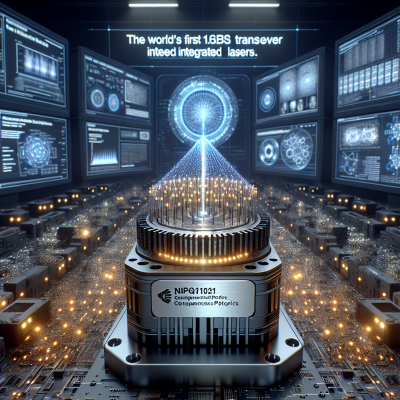
Centera Photonics Sets a New Benchmark with World’s First 1.6Tbps Transceiver
In a groundbreaking announcement, Centera Photonics Inc., a leading innovator in silicon photonics and optical interconnect solutions, has unveiled the industry’s first 1.6 terabits per second (Tbps) optical transceiver. Powered by the proprietary NewPhotonics NPG10201 chip, this revolutionary transceiver features integrated lasers and is set to reshape the future of data center interconnect (DCI) infrastructure.
A Leap Forward in Optical Interconnect Technology
Centera’s latest innovation marks a significant technological leap in the high-speed optics world. At 1.6Tbps, the transceiver supports 4 x 400Gbps optical lanes (LAN-WDM or CWDM) and is focused on advancing scalability, energy efficiency, and performance density for next-generation data centers.
The integrated laser design embedded directly into the silicon photonics chip eliminates the need for external light sources, reducing complexity and cost while boosting signal integrity and reliability.
Key Features of the 1.6Tbps Transceiver
- Ultra-High Capacity: Supports 1.6 terabits per second bandwidth — ideal for hyperscale data centers and AI/ML workloads.
- Integrated Lasers: Monolithically integrated into the silicon photonic chip using advanced MEMS technologies.
- Compact Design: Supports OSFP-XD and QSFP-DD800 form factors for flexible deployment in dense networking environments.
- Low Power Consumption: Designed to meet stringent power efficiency requirements for sustainable infrastructure.
- High Reliability: Built-in redundancy and monitoring features enhance long-term operation and uptime.
Powered by the NewPhotonics NPG10201 Chip
At the heart of Centera’s innovation lies the NewPhotonics NPG10201 chip, a next-gen silicon photonics engine that integrates modulators, photodetectors, lasers, and passive components all on a single die. This tight monolithic integration helps minimize signal loss, improve thermal efficiency, and drastically reduces the physical footprint of optical components.
Benefits of the NPG10201 Chip Architecture
- Scalability: Future-proofs data center networks to accommodate increasing bandwidth requirements.
- Integration: Reduces system complexity and bill-of-materials costs thanks to fewer discrete components.
- Compatibility: Seamlessly integrates with standard high-density networking equipment.
Market Implications and Industry Reception
As cloud computing, AI, and big data analytics push network traffic to unprecedented levels, data centers are under increasing pressure to meet bandwidth and latency demands. Centera’s 1.6Tbps transceiver addresses these challenges head-on, enabling:
- Faster AI and ML Processing: Supports accelerated inter-GPU communication for large-scale distributed computing.
- Higher Density Networking: Enables more data to pass through fewer ports, reducing switch sizes and interconnect complexity.
- Lower Operational Costs: Combines higher data rates with fewer components for simplified maintenance and deployment.
Early feedback from technology partners and hyperscale cloud operators has been overwhelmingly positive, with trials already underway in select data centers across the Asia-Pacific and North America regions.
Centera’s Vision for Future Connectivity
Centera Photonics has long been at the forefront of silicon photonics technologies, and this latest milestone solidifies its leadership in driving next-gen optical interconnection. With this 1.6Tbps transceiver, the company is not only responding to market needs but is also anticipating the future trajectory of high-performance computing and cloud infrastructure.
Looking ahead, Centera is focused on:
- Expanding its product portfolio to include even higher-speed modules such as 3.2Tbps and beyond.
- Collaborating with chipset vendors and system integrators to ensure seamless end-to-end compatibility.
- Driving energy-efficient designs to support sustainable, eco-friendly data center architectures.
Conclusion
With the launch of the 1.6Tbps transceiver powered by the advanced NewPhotonics NPG10201 chip, Centera Photonics is redefining the boundaries of what’s possible in optical interconnects. This not only marks a technological triumph but also lays the foundation for the next wave of ultra-high-speed, energy-efficient data centers.
As the demand for faster, smarter, and more sustainable connectivity continues to rise, Centera’s innovation is a strong signal of what the future holds for the networking industry.


Leave a Reply